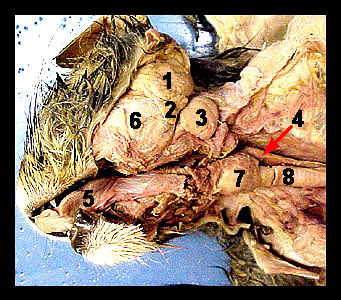|
|
||||||||||||||||||||||||||||||||||||||||||||||||||||||||||||||||||||||||||||||||||||||||||||||||||||||||||||||||||||||||||||||||||||||||||||||||||||||||||||
|
The mouth, also termed the oral or buccal cavity, is the point of entry for food into the digestive system. Its anterior boundary is formed by the lips. The floor of the mouth is formed by the tongue. Saliva is a fluid that is secreted by accessory digestive glands called salivary glands lying in or just outside the oral cavity. When food enters the mouth large amounts of saliva are secreted and the saliva functions to lubricate, dissolve, and chemically break down the food. In the human and cat there are three major pairs of salivary glands: the parotid, submandibular and sublingual glands. The oval-shaped parotid gland can be recognized by its lobulated texture. The parotid duct emerges from the front of the gland, crosses the large cheek muscle (masseter) and perforates the mucous membrane of the upper lip opposite the last premolar tooth. A submandibular gland lies posterior to the angular process of the jaw and to the ventral border of the parotid. It is a large, oval gland having the same lobulated texture as the parotid gland. Note: There is a lymph node in this area that is easily mistaken for a salivary gland. The submandibular duct emerges from the front of the gland and passes forward. A small, elongated sublingual gland is located beside the posterior one-third of the submandibular duct and generally abuts against the submandibular gland. It is drained by a tiny duct which parallels the submandibular duct but is hard to distinguish grossly. |
|
